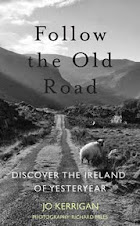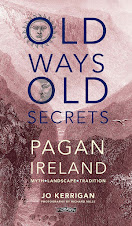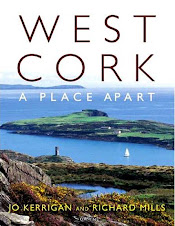But... and this is where the inadvisability comes in - the project doesn't always work. In my case, it was back last January when I was battling the flu bug from Hades and got the feverish idea late one night of creating a beautiful guernsey from a book of Japanese patterns, using a particularly gorgeous cone of violet pure wool I'd snaffled on a trip to Texere Yarns in Bradford some time back.

This was the yarn, if you remember. And you may also remember if you read that post, that I realised the error of my ways about half an hour into the project and frogged what little I'd done.
Only... I'd plied the yarn double, to get it up to usable thickness, hadn't I?
And... this is undoubtedly one of the rarest and most attractive violet yarns you've ever seen, isn't it?
And... I've just got the hang of combining machine knitting with handwork, haven't I? Which opens up delectable new possibilities of working whole garments in hitherto impossible fine gauge yarns?
So it became clear that the violet yarn needed to be unplied.
No worries. Got a ball winder now. Got several skein winders. Surely two different machines can be brought into use together to return the yarn to its original gauge? (Stand by Ireland, the industrial revolution is about to hit your shores at last).
Of course it never works out as simply as you think. Even when you wind a ball casually by hand (or, in my case, flu-ridden last January, feverishly and incoherently and quite badly), you inevitably twist it. And that twist is seriously bad news for unplying. What should have been a fairly easy task of winding a skein and a ball at the same time turned into a major task, involving swearing under the breath and the bringing in of any handy local hook or knob or surface to deal with tangled loops and lengths.

There are lengths and loopings on the floor there too, if you look closely enough.

Here's a closeup of my adorable Victorian skein winder which I persuaded my dear friend Warren Ogden of Craftspun Yarns to sell to me. It's all cast iron and brass, with a lovely dial that counts up to 80 yards, and when you're winding you can't hear a thing, it all runs silently and smoothly. Love it, even if my 2 metre skein winder is a little more practical for the dyeing and selling side. You simply can't beat this wonderful old 19th century machinery. Warren called it something else, I can't remember what, but it was originally designed for making up little sample skeins for customers. He still uses one himself - pop into his lovely shop in Johnstown not far from Dublin and you'll see it in action.
I may just have mentioned a few odds and ends that I was trying to finish up in my last posting. Well I soldiered on with those, much encouraged by your support. As advised by BB, I went for the easiest one first, and completed the Tofutsies in short order.

I am enchanted by the way the colour works out on this yarn - in the ball it looks like a mixed scrimmage, but when you knit it, suddenly waves and stripes and pools appear and it's all a lot of fun.
I was so touched by the number of you who sent Tofutsies to West Cork after I offered to trade for my hand-dyed. It is certainly a winner on the sock machine and I now have enough to see how every colourway in the range looks when knitted up. The socks are cool and light for summer and wash in the machine like a dream. Thank you. You really are the best, my worldwide gang of knitter friends.

One Conwy sock is finished, and the other is started, no more than that. Been experiencing a bit of RSI in the thumb joint from fine sock work, and stiff shoulders too, so had to slow down on the thinner yarns and needles a bit while Chinese massage worked its miracles.
Oh by the way, while I think of it, you've a chance to get your own creativity and brilliance recognised! The moderators of Sock Madness are looking for pattern submissions for next year's crazy event (one of the daftest, also one of the greatest going), and you need to get started right away. Look up the rules on the Ravelry group and start working on that pattern NOW. Well of course you're on Ravelry. If you're a knitter and aren't, WHY?

The mohair boucle wrap has had another few inches added. It just goes on, that yarn. The ball never seems to get any smaller! Sooner or later I'm going to have to take a decision and cut it, bind off, finish.
What do you mean, I haven't got much done? It's only a few days since I posted - oh, gosh, is it as long as that?
Well - OK, there were a couple of distractions. Pleasant ones.
Confirmed and total handknitters, purists, look away now. I'll tell you when it's safe to come back.
I've been machine knitting. On a flatbed.
You've latched on to that already anyway, from comments further up, but here it's time to come out of the closet and admit that machine knitting can be a whole lot of fun. To be able to create acres of stocking stitch in half an hour, to whip up a pair of sleeves in no time, a vest while you're getting ready to go out, is rather marvellous when you've grown accustomed to weeks of labour and very little to show for it. More, it means you can really concentrate on the complex bits instead of being so exhausted from the endless rows that you can't be bothered. Maybe a bit like having a full-time, super-efficient nanny for the children (and an additional, soundproofed, nursery wing to the house), so that when you meet them briefly in the evening before dinner, you can lavish love and delight on them instead of being a bit too tired to care? Or maybe not.
Anyway.
All the manuals and online sources advised making little swatches to get some practice. And then making striped swatches to get more practice. Which was fine, but I don't like wasting time like that. So I started making very long striped swatches. And then more of them. And then created a patchwork vest.

This isn't put together yet. The middle strip is half the length of the (doubled) side pieces and will be the centre back. Only...
Take a look at that second-last square from the top centre. The dark one (it's navy in fact).

I'd been popping down to the workshop at all hours to do a little more on the machine, and on this particular occasion, it was late and dark. I reached for the cone of navy Shetland, threaded it in, worked the square, threaded in the pale lilac, went on, and finished off.
It was only when I came to wash and block it that I realised I'd picked up a large cone of acrylic in exactly the same shade of navy (I keep it for experimental work). Will you look at that? Hideous!
I'm undecided between making the whole strip again, thereby condemning the three perfectly virtuous Shetland squares to oblivion, or making just one square and grafting it into place. What would you do? (Apart from switching on the light when working late at night, I didn't need that crack, smarty pants!)
But my second project worked out rather better.

This is the Dangerous Kimono, discreet black until you turn or move and a flash of wicked scarlet reveals itself. Got the original idea from that lovely pattern - is it Iki? - in Vicki Square's Knit Kimono, but the design is my own. Strips were all I could do as yet on the machine, so strips it would be. Wide rectangles for the sleeves (first red, then black), two long pieces for the body, going up and over the shoulder, and also with the red facing at either end, a narrower strip for centre back, and finally two very very long strips, one in black, one in red, for the band. Oh and four little red strips for the side slit facings. The final touch was a length of i-cord worked on the machine (didn't believe it would be easy, but it was), and twisted into a Celtic symbol.
Really really chuffed with this. It's in a hideously expensive and luxurious Italian mousse merino which feels like silky velvet and costs so much that when I made a mistake halfway through one of the long pieces, the only option was to frog back two or three rows v-e-r-y gently and re-hang the whole thing on the machine. (It was a lot faster to type that last sentence than it was to carry out the awful task, I tell you.)
I am so pleased with how it turned out. It's almost like a designer version of a PhD gown, isn't it? That's OK, I'm entitled. Less chance of tripping over the folds too.
OK, purists, confirmed and certificated hand-knitters, you can start reading again now.
Another job got done too, and I hadn't posted about it beforehand because it was a secret. Socks for DH.

Modelled by the man himself. (You want me to pose with them? On my feet? Me?) A nice blend of wool and cotton, tubes worked on the sock machine, cuffs, toes and heels by hand. Can't begin to tell you how nice it is to work the bulk of dark colours on a machine. Much easier on the eyes.
The socks were for his birthday. This is our birthday weekend (mine on the Friday, his on the Saturday). He got home-made pecan fudge, among other things. You should have seen me the night before, leaping from the sock finishing to the stove and back again, picking up stitches for the afterthought heel, stirring the fudge, working the decreases, chopping the pecans, grafting the toe, beating the fudge... It all got done in time.
And yes, now that you ask, I did secure a little loot for my own birthday. Just a yard or two of yarn...

From left to right, lower row at back: black worsted spun, about fingering weight; a really rare Suffolk fingering weight (hadn't scored that particular breed before, lovely grey shade); and a big cone of superwash merino fingering weight, destined for hand-dyed sock yarn. Top row, L to R, three cones of that seductive Italian mousse yarn. Front, a cone of cashwool, that Italian fine gauge merino that feels exactly like cashmere. And in the foreground, a delightful cone winder dating, I would think, from around the 1960s, which I got from the lovely Rosina at Mostly Knitting Machines, and some little treats from DH who knows my (other) weakness. Enough to keep me going for a while maybe.
But Friday was the most special day out. I knew exactly where I wanted to go - Innisfallen Island on Lough Leane in Killarney. Innisfallen is fabled in history because it was here from the 4th century onwards that the community of monks created and continued The Annals of Innisfallen, probably our earliest and most historically valuable documentary source. The original is now in the Bodleian in Oxford, where it can be cared for as it should be, but some friends of mine at Cork University have placed a translation online where everybody can benefit from it. You can look it up here.

It's only a small little island, but it's well out in Lough Leane, and you have to take a boat from Ross Castle. Which we did. Boatman Fergus does this run all the time, in between taking people right up the three lakes to Lord Brandon's Cottage for tea.
We were halfway across when I spotted something in the sky and said, 'Holy heavens, what's that?'

Those of you living in wilder parts of North America may not consider this particularly unusual, but here in Ireland we're pretty bereft of the larger raptors. Eagles, buzzards, died out long ago. But there has recently been a drive to re-introduce both the golden and the white-tailed sea eagle, and this could be none other than the sea eagle.
Of course DH grabbed his 500mm lens and started firing bursts, while Fergus obligingly brought the boat around and steered towards the thicket of trees on Innisfallen where the bird seemed to have landed. But as we got closer we saw something horrible.

Oh no, no, no, it can't be. Please don't let it be. How could the bird be dead? We'd only just seen it flying. Or - was it another one, caught and somehow trapped, unable to free itself, some time ago? Was the other one searching for it? All kinds of thoughts and half-finished sentences were running around as we edged in closer.

Thank heaven! After a few agonising minutes, it suddenly seemed to come back to life, flapped those huge wings, and got itself upright on the branch. It had to be a young bird, virtually on its first flight, then. We've seen this with smaller birds leaving the nest - often they crash land on a branch and then slip right round, their claws firmly grasping the twig, but unable to keep upright. They're fine once they work out what's happened. And so it must have been with this huge beautiful bird. Which meant that it could only just have been released. Immediately rang our friends who were masterminding the reintroduction project and they confirmed that yes, half a dozen of the birds recently donated from Norway (thanks Norway!), had been let loose that morning from a secret location way in the heart of the mountains.

This, then, with the prominent wing tag (and radio transmitter which you can't see) is the female, Feenagh. May you have a long and happy life here with us in Ireland, Feenagh, and may the wind be always underneath your wings.
It was good to have seen her land on Innisfallen too; one of my favourite poems, which dates from just about the time the Annals were being written, is an Anglo-Saxon one, The Seafarer, with the line,
The erne screams, icy-feathered...
Erne being the old name for the sea eagle (and you'll still find it as a clue in crossword puzzles to this day!)
It was a lovely birthday present for DH as well. Couldn't have timed it better, that bird.
And so the boat's keel finally grounded on the pebbly shore of Innisfallen and we entered an older world.

Although the abbey dates from the 4th century, most of the buildings are later, around the 14th century. Some scraps of the original do remain though, built into the walls of the medieval structure.

This tiny cross was discovered in the lake some years ago, and brought back to the island from whence it must surely have originated.

Hundreds of coins had been placed carefully, reverently, around and even on the little cross. There are some instinctive beliefs and rituals that lie unsuspected below the surface in all of us, until one day we are in a place where we have never been before, and suddenly know what we must do.

This is the view of the mainland and McGillicuddy's Reeks much as the monks must have seen it as they took a break from their slow illuminative and scribing work, blowing on their cramped fingers and unstiffening their joints, bent too long over a sheet of vellum.

Didn't want to leave that peaceful place, but evening was drawing on. We saw these fishermen on the lough on the way back, and one was determined to show us just how big the one that got away was!

Ross Castle really looks at its best when you come to it by water, doesn't it?
Everything went right on this day. We drove into the woods to see if we could find any of our native red deer, and we did.

This doe was protective of her young fawn who still had his dappled spots.

And then the stag came along and ushered them both away to safety. So we withdrew as quietly as we could. It's their woodland, not ours, after all.
And finally we took a long and winding and extremely circuitous route over the hills and far away. Coming down at last as dusk fell to a secret valley and the Last Homely House - or, more exactly, Gougane Barra and our dear friends at the hotel there, for a wonderful dinner. Altogether a magical day.









